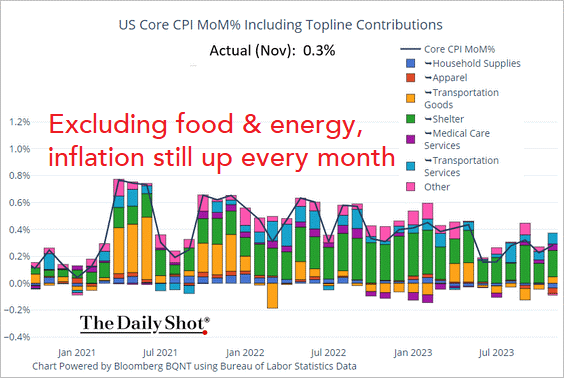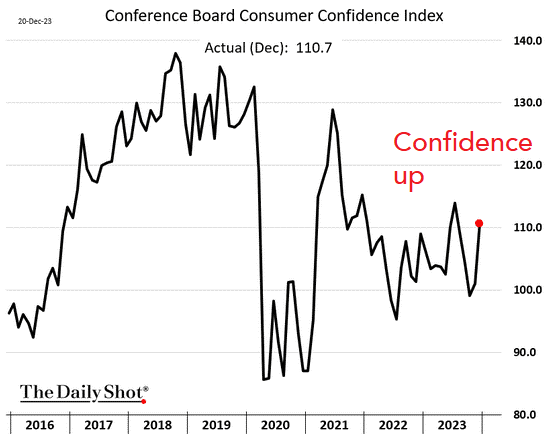Hello all - we hope you had a nice December.
It was a remarkable month with markets reaching or nearing record highs. For December, the Dow rose 4.8%, the S&P 500 gained 4.5%, and the Nasdaq, which has a higher concentration of tech stocks, added a solid 5.5%. We’ve also seen nine-straight higher weeks for both the S&P and Nasdaq, the first time that’s happened since 1983.
The year was incredible, too, with the Dow up 14%, the S&P gained 24%, and the Nasdaq was higher by 43%.
It was a remarkable month with markets reaching or nearing record highs. For December, the Dow rose 4.8%, the S&P 500 gained 4.5%, and the Nasdaq, which has a higher concentration of tech stocks, added a solid 5.5%. We’ve also seen nine-straight higher weeks for both the S&P and Nasdaq, the first time that’s happened since 1983.
The year was incredible, too, with the Dow up 14%, the S&P gained 24%, and the Nasdaq was higher by 43%.
Here’s a look at how the markets moved this month:
The chart for the past year looks impressive.
Here’s a look at how the different sectors performed this year.
A record amount of new money has flowed into the market. We’ve seen the biggest monthly inflow ever into an ETF that tracks the market.
We’ll touch on bonds, too, which had another big month. Bond yields continue to fall, which means it’s cheaper to borrow money.
When bond yields fall, bond prices rise. For investors in bond index products, like bond ETF’s, that means the ETF price moved higher. Here’s a look at the price the most popular bond ETF, the Vanguard Total Bond Index:
____
FED
What was the reason for the large increase in stocks this month? That’s easy – it’s all about the Fed.
The last two years have seen a restrictive Fed policy, where the Fed pulled back on its stimulus by printing less money and raising interest rates.
This month was a sea change for the markets as that all reversed.
The Fed shocked investors by explicitly stating that they expect to cut interest rates next year. Lower rates were something investors thought might happen, but never expected to directly hear from the Fed. This sent markets skyrocketing. (It also makes you question why bother analyzing corporations for good investments when markets rise and fall based on Fed policy.)
The comments were also confusing, since two weeks earlier the Fed had explicitly stated that they WERE NOT planning on lowering interest rates.
Economic data released in those two weeks weren’t remarkable enough to produce a sharp U-turn in policy.
However, there was one data point that DID change. The election. Donald Trump took the lead over Joe Biden and Trump leads Biden in all seven swing states.
However, there was one data point that DID change. The election. Donald Trump took the lead over Joe Biden and Trump leads Biden in all seven swing states.
A rising stock market in an election year has historically seen the incumbent win. That means a rising stock market would help Joe Biden.
The Fed and its defenders are always quick to say that the Fed is apolitical and politics never enters their thinking. But we know they are very political and all share a similar political leaning.
For example, the former Fed president, Janet Yellen, is the now the Treasury Secretary for the Biden administration. The things we’ve heard her say on the Biden’s behalf is something only a hard-core liberal would believe, and her views aren’t that far from the other Fed members.
For example, the former Fed president, Janet Yellen, is the now the Treasury Secretary for the Biden administration. The things we’ve heard her say on the Biden’s behalf is something only a hard-core liberal would believe, and her views aren’t that far from the other Fed members.
-
Another possible reason for the sharp pivot from the Fed is higher borrowing costs for the U.S. government. Our government spending is at record levels, which is a worrisome stat (especially when outside of a wartime which usually has the higher spending).
Treasury Secretary Janet Yellen has publicly mentioned that the higher rates are making it harder for the government to borrow money. With the massive amount of debt and higher interest rates, we spend more on interest payments on the debt than we do on defense!
Having Jay Powell and the Fed lower borrowing costs will make it cheaper and easier for the U.S. government to borrow money.
We think these are the two main reasons for the sharp pivot from the Fed – a higher market in the election year and lower borrowing costs for the U.S. government. There has been no other data points that justify such a reversal in such a short time.
We think these are the two main reasons for the sharp pivot from the Fed – a higher market in the election year and lower borrowing costs for the U.S. government. There has been no other data points that justify such a reversal in such a short time.
____
INFLATION
Inflation has been trending lower, which has been helpful for the Fed. On a year-over-year measurement, inflation moved lower again this month.
Inflation has been higher every month, but it has been trending lower. The charts look a little funky this month, but you get the point.
Excluding energy and food, which economists call the “core” measurement, inflation is still rising every month.
____
OTHER ECONOMIC DATA
First we’ll start with the leading economic indicators, which we’ve talked about for months. This index combines many other indicators that tend to signal the direction of the economy (like weekly unemployment numbers, building permits, etc.).
This index has been lower for 20-straight months now. It has never gone this low without a recession following, although this is something we’ve been saying for many months and a recession still hasn’t come.
Here are the various indicators used in the leading indicator index:
The manufacturing sector still appears to be contracting while the services sector showed slight improvement.
Retail sales ticked higher last month:
Durable goods (these are items with a longer life, like a phone or refrigerator) showed a nice gain after a large drop in the previous month.
Consumer confidence moved higher:
Small business optimism was slightly lower, though:
____
Where does the market go from here?
Our indicators show that the market is very expensive here. However, the shift from the Fed lead to a sea change in the market and gave investors the green light to pile in. New money from investors may keep the market afloat here. We wouldn’t be sellers at this time, but aren’t excited about putting new money in, either.
This commentary is for informational purposes and is not investment advice, an indicator of future performance, a solicitation, an offer to buy or sell, or a recommendation for any security. It should not be used as a primary basis for making investment decisions. Consider your own financial circumstances and goals carefully before investing. Past performance cannot guarantee results.
























